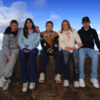Social anxiety disorder (SAD), also referred to as social phobia, is listed in the Diagnostic and Statistical Manual of Mental Disorders, Fifth Edition (DSM-5) as a chronic mental health condition. The National Institute of Mental Health (NIH) explains that social anxiety disorder is “characterized by persistent fear of one or more social or performance situations in which the person is exposed to unfamiliar people or to possible scrutiny by others.” An individual with social anxiety disorder will experience a stronger and more intense sense of anxiety surrounding uncomfortable social situations than someone without SAD. The exact cause for developing social anxiety disorder remains unknown. Research suggests that it is likely due to a combination of contributing factors such as psychological, environmental, genetic, and developmental factors.
Signs and Symptoms
The symptoms that can manifest with social anxiety disorder can be debilitating and interfere with one’s ability to function in his or her daily life. Every young person is unique and will have his or her own set of challenges with regards to social anxiety. Common examples of signs and symptoms that an individual with SAD may exhibit could include any combination of the following, provided by the Mayo Clinic:
- Excessive worry and/ or fear
- Muscle tension
- Blushing
- Sadness
- Crying
- Nausea
- Agitation
- Fast heartbeat
- Sweating
- Irritability
- Shaking
- Poor eye contact with others
- Low self-esteem/ low self-worth
- Dizziness or lightheadedness
In addition to the above, young people with social phobia may have frequent self-deprecating thoughts and/ or constant thoughts of inadequacy. It is important to note that social anxiety disorder symptoms can change over time.
DSM-5 Diagnostic Criteria
The diagnosis process for social anxiety disorder typically includes several components such as a physical exam, reviewing one’s symptoms, completing a self-report questionnaire, and meeting the diagnostic criteria provided in the DSM-5. The diagnostic criteria outlined in the DSM-5 for social anxiety disorder include:
- Persistent, intense fear or anxiety about specific social situations due to fear of possibly being judged, embarrassed or humiliated
- Avoidance of anxiety-producing social situations or enduring them with intense fear or anxiety
- Excessive anxiety that is out of proportion to the situation
- Anxiety or distress that interferes with one’s daily living
- Fear or anxiety that is not better explained by a medical condition, medication, or substance abuse
To secure the most effective treatment, it is essential to obtain an accurate diagnosis from a qualified mental health professional. With proper treatment a teenager can learn to effectively manage the symptoms of his or her social anxiety disorder.
For Information and Support
Every family in need of mental health treatment must select a program that will best suit the needs of their family. When one member of a family struggles, it impacts everyone in the family unit. To maximize the benefits of treatment we work closely with the entire family to ensure that everyone is receiving the support they need through these difficult times. Seeking help is never easy, but you are not alone! If you or someone you know needs mental health treatment, we strongly encourage you to reach out for help as quickly as possible. It is not uncommon for many mental health difficulties to impact a person’s life, long term. Pursuing support at the beginning of one’s journey can put the individual in the best position to learn how to manage themselves in a healthy way so they can go on to live happy and fulfilling lives.
OUR KNOWLEDGEABLE ADMISSIONS TEAM CAN BE REACHED 24/7 AT INFO@PACIFICRTC.COM OR CALL: 800-531-5769 We are available to answer any questions you may have regarding mental health treatment and our residential program, anytime. Contact us today using the form to the right.






